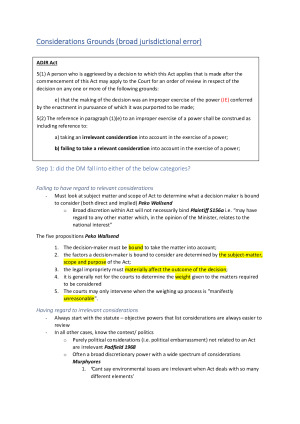HD - STEP BY STEP EXAM SCAFFOLDS
Subject notes for USYD LAWS2010
Description
I got an HD using these scaffolds - just the case principles extracted under all the main points. Easy to follow step by step process - you can't go wrong! These are basically all you need for the exam! Please see my long notes sold seperately for full explanations. OUTLINE/TABLE OF CONTENTS - Problem Question Outline: Judicial Review 4 Threshold Issues 4 Does the court have jurisdiction? 4 Step 1. Commonwealth or State? 5 State 5 Commonwealth 6 Step 2: is it a decision/conduct? 6 Step 3: is it of administrative character/under an enactment? (if not, say Q a regulation, go to JA) 7 Judiciary Act 1903 (Cth) S39B Original Jurisdiction of Federal Court: 8 Step 4 (or 2): is it a public of private decision? (all courts) 8 Does the Applicant have Standing? 9 Common Law Test: Sufficient Interest (ACF) 9 Statutory Test: Person aggrieved 9 Grounds of Review 10 Is the regulation within the power conferred by the Act? (Judicial Errors of Lawmakers - Judicial Review of Rule-Making/Delegated legislation) 10 Delegated Legislation/regulations 10 Means/End Distinction 11 Narrow Judicial Errors of Decision-Makers (Errors of Law & Fact) 11 Q 1: was there an error in interpreting or applying the statute? 11 The fact/law distinction 11 Q 2: No evidence? 11 Q 3: Is an ‘Objective Jurisdictional Fact’ missing? 12 Q 4: or is it a subjective jurisdictional fact/opinion? 12 was the fact finding illogical or irrational? 12 Procedural Fairness (broad jurisdictional error) 13 Step 1: is procedural fairness implied? 13 Common Law General Rule Kioa 13 Does an exception apply? 13 Advisory Reports and Recommendations 14 Urgency 14 Step 2: Content of the hearing rule (checklist below) 14 Notice: disclosure of adverse information and critical issues 14 Confidential information / national security? 14 Disclosure of adverse conclusions 14 Fair Hearings 14 Witness and Cross Examination 15 Responding to arguments 15 Fraudulent actions of third party 15 The Rule Against Bias 15 2 step test 15 Main categories of bias 15 Step 1: Identify type of Bias 15 Actual bias / prejudgment 15 Extraneous Information 16 Step 2: Logical connection between apprehended bias and decision 16 Multi Member Committees 16 Step 3: Exceptions 16 Common Law principle of Statutory Exclusion & Necessity 16 Waiver & Recusal 16 Considerations Grounds (broad jurisdictional error) 17 Step 1: did the DM fall into either of the below categories? 17 Failing to have regard to relevant considerations 17 Having regard to irrelevant considerations 17 Step 2: did DM partake in an “active intellectual engagement” with requisite considerations 18 Step 3: Or did DM take into account an improper or Unauthorised Purpose 18 Policies (Jurisdictional Error) 18 Representations & Estoppel 19 Acting under dictation (jurisdictional error) 19 Statutory directions 20 Unauthorised Delegations 20 Does Administrative Necessity Apply? 20 Questioning the Caltona Principle 21 Unreasonableness (broad jurisdictional error) 21 Threshold 22 Inconsistency of treatment 22 Oppressive treatment 22 Statistical Problems 22 Failure to make inquiries 22 Uncertainty (jurisdictional error) 22 Jurisdictional Error Overview + Breach of Statutory Requirements (when it may or may not result in jurisdictional error) 23 Step 1: What is necessary to establish a jurisdictional error? 23 Step 2: did the legal error materially affect the outcome of the case? 24 Step 3: what will be the legal status of the decision? Invalid or unlawful? 24 Remedies (if any) to be granted 24 The Prerogative Writs (Common Law) 24 Remedy 1: Certiorari 24 Certiorari: error of law on the face of the record 25 Remedy 2: Prohibition 25 Remedy 3: Mandamus 26 Remedy 4: Injunctions 26 Equitable remedy: Declarations 26 Constitutional writs 26 ADJR Remedies 27 ADJR: Federal Court discretion to grant remedy 27 Severance 28 Breach of Statutory Duty to Give Reasons 28 Statutory Attempts to Exclude and Restrict Judicial Review (Privative Clauses – Exception?) 29 Step 1: Does the clause exclude jurisdiction to review decision? 29 Commonwealth 29 State 29 Step 2: does a clause exclude ability to invalidate decision? 29 Step 3: is the clause constitutionally invalid because it impairs the entrenched minimum provision for judicial review? 30 Examples 30 Merits Review 30 Step 1: is it a q of law? 30 Administrative Appeal Tribunal 30 Step 1: Does the AAT have jurisdiction? 30 Step 2: Does the applicant have standing? 30 Step 3: Did the appellant request reasons for their decision? 31 Step 4: what occurs at hearings before the tribunal? 32 Step 5: What decision-making powers does the AAT have? 32 Step 6: Unhappy with AAT? appeal decision to the Federal Court 33 Common Law Rules of AAT 33
USYD
Semester 1, 2020
33 pages
9,782 words
$29.00
5
Campus
USYD, Camperdown/Darlington
Member since
March 2018
